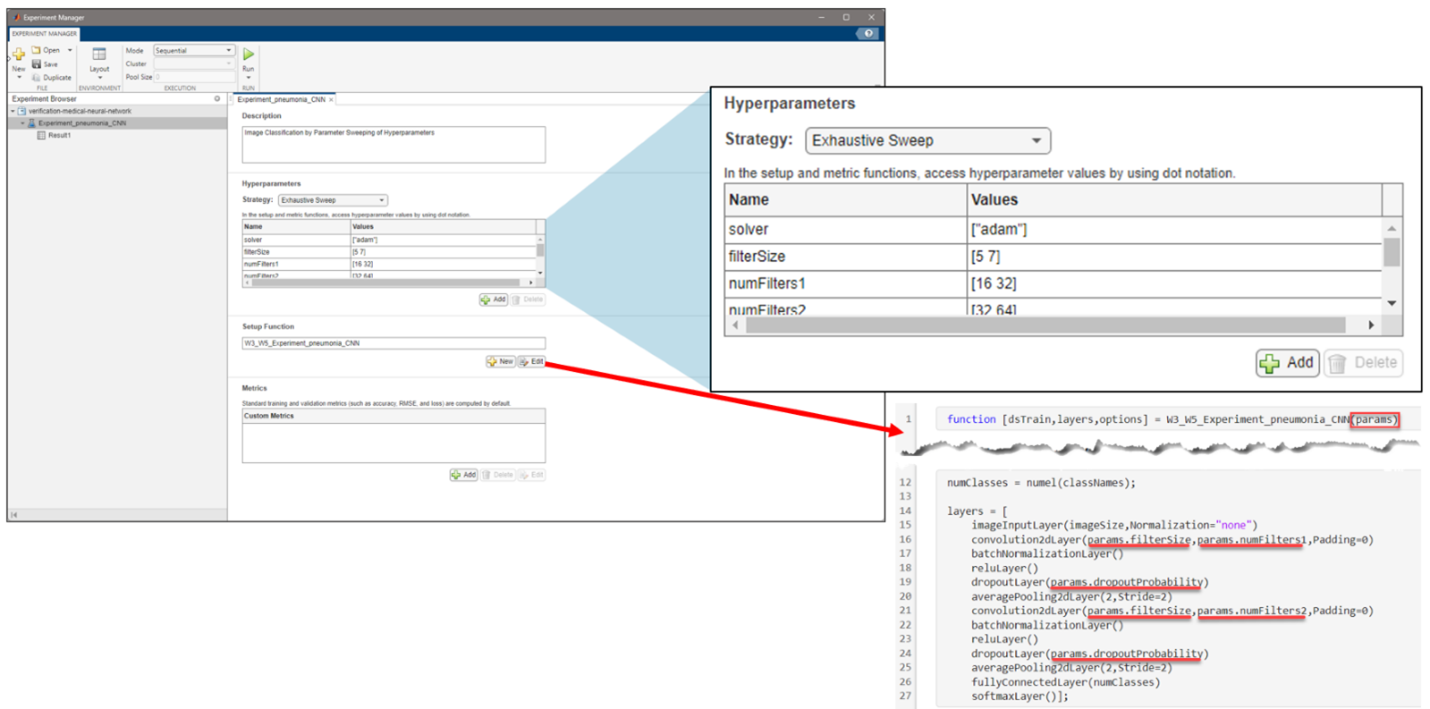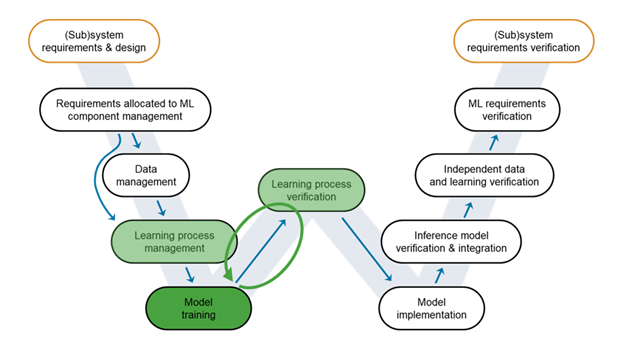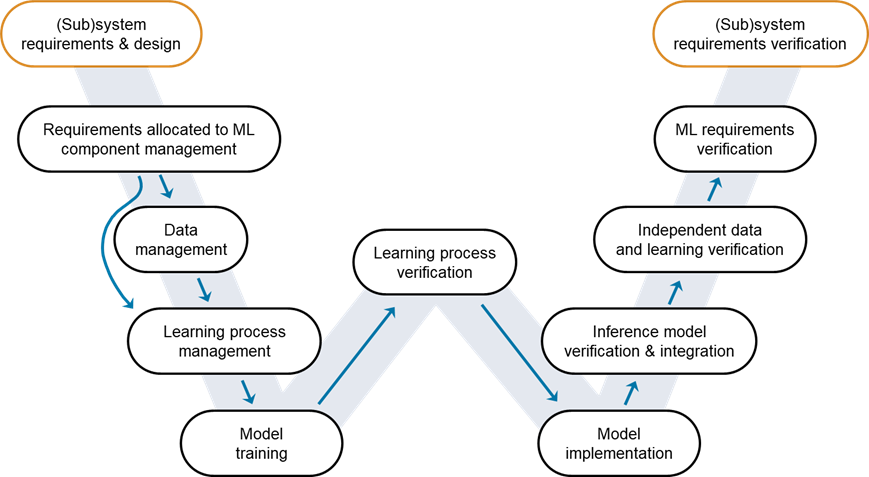Verification and Validation for AI: From requirements to robust modeling
 Figure 1: W-shaped development process. Credit: EASA, Daedalean.
This blog post focuses on the steps you need to complete and iterate on starting with collecting requirements and up to creating a robust AI model. To illustrate the verification and validation steps from requirements to modeling, we will use as an example the design of a pneumonia detector.
Figure 1: W-shaped development process. Credit: EASA, Daedalean.
This blog post focuses on the steps you need to complete and iterate on starting with collecting requirements and up to creating a robust AI model. To illustrate the verification and validation steps from requirements to modeling, we will use as an example the design of a pneumonia detector.
Verification and Validation for Pneumonia Detection
Our goal is to verify a deep learning model that identifies whether a patient is suffering from pneumonia by examining chest X-ray images. The image classification model needs to be not only accurate but also highly robust to avoid the potentially severe consequences of a misdiagnosis. We’ll identify the problem and take it through all the steps in the W-shaped development process (W-cycle for short). The dataset we will be using is the MedMNISTv2 dataset. If you are familiar with MNIST for digit classification, MedMNIST is a collection of labeled 2D and 3D biomedical lightweight 28 by 28 images. We decided to use this dataset because of its simplicity and the ability to rapidly iterate over the design. More specifically, we’ll use the PneumoniaMNIST dataset, which is part of the MedMNISTv2 collection.Requirements Allocated to ML Component Management
We’ll start with the first step in the W-cycle related to AI and Machine Learning; collecting the requirements specific to the Machine Learning component. Note that for any non-Machine Learning component items, you can follow the V-cycle frequently used for development assurance of traditional software. At this stage, key questions to consider are:- Are all the requirements implemented?
- How are the requirements going to be tested?
- Can the model behavior be explained?
Data Management
The next step in the W-cycle is Data management. Since we are solving a supervised learning problem, we need labeled data for training the model. MATLAB offers various labeling apps (including Image Labeler and Signal Labeler) that are extremely useful at this point, allowing you to label your dataset interactively (and with automation). Thankfully, data has already been labeled into “pneumonia” and “normal” images. I would have to seek expert advice to label X-ray images or find the right algorithm to automate the process. The data set has also been partitioned into training, validation, and testing sets. So, we don’t need to worry about that either. All we need to worry about at this point is to conveniently manage our images. The imageDatastore object allows you to manage a collection of image files where each individual image fits in memory, but the entire collection does not necessarily fit. Indeed, the MedMNIST images are small and will all fit in memory, but using a data store allows you to see how you can create a scalable process for more realistic workflows. By indicating the folder structure and that the label source can be inferred from the folder names, we can create a MATLAB object that acts as an image data repository.trainingDataFolder = "pneumoniamnist\Train"; imdsTrain = imageDatastore(trainingDataFolder,IncludeSubfolders=true,LabelSource="foldernames"); countEachLabel(imdsTrain)
ans =
2×2 table
Label Count
_________ _____
normal 1214
pneumonia 3494
Note that the dataset is imbalanced towards more pneumonia samples. So, this should be considered in the loss function as we train the model.
Learning Process Management
At this stage, we’d like to account for all the preparatory work before the training phase. We’ll focus on developing the network architecture and choosing the training options (training algorithm, loss function, hyperparameters, etc.). You can easily design and visualize the network interactively using the Deep Network Designer app. Once you have designed the network (in this case, a simple CNN for image classification), MATLAB code can be generated for training.numClasses = numel(classNames);
layers = [
imageInputLayer(imageSize,Normalization="none")
convolution2dLayer(7,64,Padding=0)
batchNormalizationLayer()
reluLayer()
dropoutLayer(0.5)
averagePooling2dLayer(2,Stride=2)
convolution2dLayer(7,128,Padding=0)
batchNormalizationLayer()
reluLayer()
dropoutLayer(0.5)
averagePooling2dLayer(2,Stride=2)
fullyConnectedLayer(numClasses)
softmaxLayer];
However, coming up with the optimal hyperparameters might not be so straightforward. The Experiment Manager app helps you find the optimal training options for neural networks by sweeping through a range of hyperparameter values or using Bayesian optimization. You can run different training configurations, even in parallel, if you have access to the necessary hardware.
 Figure 4: Setting up the problem in Experiment Manager to find an optimal set of hyperparameters from the exported architecture in Deep Network Designer.
Figure 4: Setting up the problem in Experiment Manager to find an optimal set of hyperparameters from the exported architecture in Deep Network Designer.
Model Training
It is now time to train the model - or more accurately, models. We first run the experiment we have configured in the Experiment Manager app. This gives us an excellent model to start with. Figure 6: An iterative approach towards building an accurate and robust model.
However, as we’ll see in a future blog post, this data-augmented training will not be enough for our purposes. So, our last iteration will involve using a training algorithm called the Fast Gradient Sign Method (FGSM) for Adversarial Training (learn more). The goal is to generate adversarial examples during training, which are visually similar to the original input data but can cause the model to make incorrect predictions.
Stay tuned for our next blog post. We’ll address the next stage in the W-cycle, the exciting topic of Learning process verification.
Figure 6: An iterative approach towards building an accurate and robust model.
However, as we’ll see in a future blog post, this data-augmented training will not be enough for our purposes. So, our last iteration will involve using a training algorithm called the Fast Gradient Sign Method (FGSM) for Adversarial Training (learn more). The goal is to generate adversarial examples during training, which are visually similar to the original input data but can cause the model to make incorrect predictions.
Stay tuned for our next blog post. We’ll address the next stage in the W-cycle, the exciting topic of Learning process verification.  Cleve’s Corner: Cleve Moler on Mathematics and Computing
Cleve’s Corner: Cleve Moler on Mathematics and Computing The MATLAB Blog
The MATLAB Blog Guy on Simulink
Guy on Simulink MATLAB Community
MATLAB Community Artificial Intelligence
Artificial Intelligence Developer Zone
Developer Zone Stuart’s MATLAB Videos
Stuart’s MATLAB Videos Behind the Headlines
Behind the Headlines File Exchange Pick of the Week
File Exchange Pick of the Week Hans on IoT
Hans on IoT Student Lounge
Student Lounge MATLAB ユーザーコミュニティー
MATLAB ユーザーコミュニティー Startups, Accelerators, & Entrepreneurs
Startups, Accelerators, & Entrepreneurs Autonomous Systems
Autonomous Systems Quantitative Finance
Quantitative Finance MATLAB Graphics and App Building
MATLAB Graphics and App Building











Comments
To leave a comment, please click here to sign in to your MathWorks Account or create a new one.